Abstract
Class II histone deacetylases (HDACs) are considered as potential targets to treat Alzheimer’s disease (AD). Previously, C-3 substituted phenothiazine-containing compounds with class II HDAC-inhibiting activities was found to promote neurite outgrowth. This study replaced phenothiazine moiety with phenoxazine that contains many C-3 and C-4 substituents. Some resulting compounds bearing the C-4 substituent on a phenoxazine ring displayed potent class II HDAC inhibitory activities. Structure-activity relationship (SAR) of these compounds that inhibited HDAC isoenzymes was disclosed. Molecular modelling analysis demonstrates that the potent activities of C-4 substituted compounds probably arise from π-π stacked interactions between these compounds and class IIa HDAC enzymes. One of these, compound 7d exhibited the most potent class II HDAC inhibition (IC50= 3–870 nM). Notably, it protected neuron cells from H2O2-induced neuron damage at sub-μM concentrations, but with no significant cytotoxicity. These findings show that compound 7d is a lead compound for further development of anti-neurodegenerative agents.
Introduction
Due to the rapid increase in the elderly population globally, age-related neurodegenerative diseases such as Alzheimer’s disease (AD), and Parkinson’s disease (PD) are attracting increasing attentionCitation1. AD accounts for 60% to 80% of cases of dementia in aged patientsCitation2. The global prevalence of AD, which is gradually increasing, is estimated to reach 152.8 million in 2050. In 2021, AD was the fourth most common cause of death for elderly people in the US. Accordingly, AD imposes a heavy burden on health and welfare systems and economic development. AD patients typically have symptoms from mild cognitive impairment in the early stages to severe memory impairment in the late stagesCitation1,Citation3. To date, only three classes of FDA-approved drugs treat AD. They include acetylcholine esterase (AChE) inhibitors – rivastigmine, galantamine, and donepezil, N-methyl-D-aspartate (NMDA) receptor antagonist – memantine, and amyloid beta (Aβ)-targeting antibody – aducanumabCitation4,Citation5. These five drugs only alleviate some symptoms of AD, but without slowing its progression. The need for an effective therapeutic treatment for AD remains unmet.
Histone deacetylases (HDACs) that are recognised as epigenetic enzymes can regulate gene expression, but without modifying the gene sequence. HDACs catalyse the removal of the acetyl group from lysine residue on histone, forming the condensed nucleosome bead structure that inhibits gene expressionCitation6,Citation7. HDACs also catalyse the acetylation of some nonhistone proteins such as tubulin, HSP90, and P53Citation8–10. These established findings show that HDACs are associated with a wide spectrum of cellular events. HDACs, which contain 18 isoform enzymes, are divided into four classes depending on their sequence homology, cofactor, and intracellular distribution. Class I, II, and class IV HDACs have Zn as a cofactor in their catalytic domain, whereas class III HDACs are NAD+-dependent. Of these Zn-dependent HDAC isoform enzymes, class IIa HDACs have a weak but measurable deacetylase activity, and class IIb HDACs are able to deacetylate histone and non-histone proteins. Additionally, class II HDACs can be subdivided into class IIa HDACs (4, 5, 7, and 9); and class IIb HDACs (6 and 10)Citation11.
Increasing evidence demonstrates that some of these class II HDAC isoforms are involved in learning, memory formation, and neuroplasticityCitation9,Citation12,Citation13. Studies reveal that neurodegenerative diseased tissues have greater expression of class II HDAC isozymes than normal counterpart tissues. For instance, the overexpression of HDAC4 is implicated with neurotoxicity and neurodegeneration in murine neuron cellsCitation7. The levels of HDAC5 in the frontal cortex of AD patients exceed those of normal individualsCitation14. The overexpression of HDAC7 reduces β-catenin activity, downregulating Wnt/β-catenin signalling that is related to AD progressionCitation15,Citation16. The elevation of HDAC9 is found to inhibit the gene expression of choline acetyltransferase (ChAT), reducing the levels of the neurotransmitter acetylcholine (ACh), which is critical for memory formation and CNS functions. However, the inhibition of HDAC9 promotes ACh synthesis as well as neuron dendrite outgrowthCitation17. Hyperphosphorylated tau protein causes the formation of intracellular neurofibrillary tangles (NFTs) that are associated with synaptic dysfunction and neuron impairmentCitation10. HDAC6 inhibition enhances tau protein acetylation, suppressing the phosphorylation of tauCitation8. In addition to causing tauopathy in AD, HDAC6 inhibition attenuates Aβ aggregation Citation18and alleviates cognitive impairment in an in-vivo AD mouse modelCitation9. HDAC6 levels are significantly elevated in the hippocampus and the cortex of the AD patient's brainCitation19. Notably, the class IIb HDAC6 inhibitors tubastatin A and ACY1215 demonstrated in-vitro as well as in-vivo anti-AD activityCitation20. Class IIa HDAC inhibitor MC1568 exhibited activity in a neurodegenerative disorder animal modelCitation12. Class II HDAC inhibitor W2 not only inhibits the aggregation of Aβ, but also improves cognition in AD miceCitation21. These established findings suggest that class II HDACs are potential targets in the treatment of neurodegenerative diseases, especially AD.
Owing to the role of class II HDACs implicated with AD as mentioned, we sought to develop potent class II HDAC inhibitors against AD. The reported HDAC inhibitors can be structurally divided into three moieties, which include a zinc-binding group (ZBG), a hydrophobic carbon linker, and a capping group also in hydrophobic nature. Previously, we have incorporated various commercially available phenothiazines, which have different C-3 substituents, as the cap group into ZBG hydroxamic acid using a benzyl linker Citation22 (Scheme 1). Several resulting compounds exhibited more potent class II HDAC-inhibiting activities than did the clinically used HDAC inhibitor SAHA. In addition to exhibiting potent enzyme inhibitory activity, they can protect neuron cells from H2O2-induced neuron injury, but with no significant cytotoxicity. Despite their potent class II HDAC inhibition, the investigation of SAR of C-3 substituted phenothiazine compounds is only limited.
Scheme 1. Design of potent class II HDAC inhibitor 7d from investigating structure-activity relationship (SAR) of phenothiazine-based hydroxamates
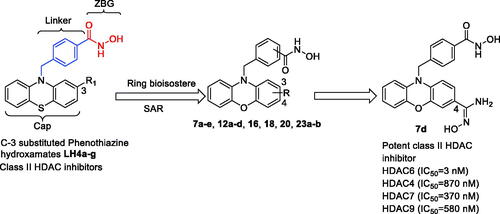
Phenoxazine is a scaffold commonly found in agents that exhibit anticancer, sedative, antiepileptic, tranquillizing, spasmolytic, antitubercular, anthelminthic andCitation23,Citation24, in particular, neuroprotective activitiesCitation25. Phenoxazine exhibits potent antioxidant activity in the range of nM concentrationsCitation26. It displays a stronger protective effect against MPP+-induced neurotoxicity than does phenothiazineCitation26. Furthermore, the molecular modelling analysis that unsubstituted phenoxazine-containing compound 7a bound to HDAC6 demonstrated a small pocket near the phenoxazine ring of compound 7a as shown in Fig. 1S. We suggest the substituents, such as functional groups capable of hydrogen bond formation (amide, hydroxyimidamide, and nitrile) and hydrophobic moieties added to the C-4 position of the phenoxazine ring, potentially provide the additional interactions to residues F680 and L749 in the small pocket of HDAC6 protein (). The C-4 substitution may further enhance the enzyme-inhibiting activity, which was supported by C-4 hydroxyimidamide-substituted phenoxazine 7d with greater activity than unsubstituted phenoxazine 7a. In addition, we previously verified compound LH4f, which has C-3 amide on phenothiazine, exhibited potent class II HDAC inhibition. Due to the various properties of phenoxazine as well as the substituent observations of phenoxazine ring as described above, in this investigation, the phenothiazine moiety of C-3 substituted phenothiazine series compounds LH4a-g is replaced with their ring bioisostere phenoxazine that contain various C-3 and C-4 substituents using different hydrogen bond formation groups and hydrophobic aryl moieties (Scheme 1). This effort reveals the structure-activity relationship (SAR) of phenothiazine-derived phenylhydroxamates, which inhibit different HDAC isoform enzymes, thus, yielding potential agents for targeting neurological disorders. Among the resulting compounds, a potent class II HDAC inhibitor 7d was identified to protect neuron cells from H2O2-induced neurotoxicity, but with slight cytotoxicity. These findings suggest that this compound can serve as a lead compound for further improvement of the biological activity targeting AD.
Materials and methods
General procedure
NMR spectra (1H- and 13C- NMR) were obtained using the Bruker Fourier 300 and AVIII 500 spectrometer with standard plus programs. The chemical shifts were presented in parts per million (ppm, δ) with TMS as an internal standard. The MS data were measured on a Finnigan Mat TSQ-7000 mass spectrometer (ESIMS and HRESIMS). HPLC was performed using a C18 column (250 mm x 4.6 mm, Waters) and an L-2130 pump (Hitachi, Ibaraki, Japan). Column chromatography was performed on silica gel (70–230 mesh, Merck, Darmstadt, Germany). The TLC analysis was performed on silica gel plates (KG60-F254, Merck). A microplate spectrophotometer Victor 2X (Perkin Elmer Fremont, CA, United States) was used for fluorometric analysis; an Envision 2104 Multilabel Reader (Perkin Elmer, CA, United States) was used for luminescence analysis, and a Sunrise microplate reader (TECAN, Männedorf, Switzerland) was used for absorbance analysis. Unless otherwise mentioned, all chemicals and materials were used as received from commercial suppliers without any purification. Anhydrous dichloromethane was distilled from calcium hydride under N2.
N-Hydroxy-4-[(10H-phenoxazin-10-yl)methyl]benzamide (7a)
To a solution of compound 6a (100 mg, 0.30 mmol) in MeOH-THF (1: 1, 8 ml) was added the mixture of 50%NH2OH(aq) (2 ml) and NaOH (60 mg, 1.50 mmol) at 0 °C. The reaction mixture was warmed to RT and the resulting solution was stirred for 2h. The reaction mixture was diluted with distd-H2O and neutralised to pH 7–8 at 0 °C to give precipitate. The solid was washed with EtOAc and distd-H2O to give compound 9Citation27 (89 mg, 89%) as a yellow solid. Mp 213–215 °C; 1H-NMR (Acetone-d6, 300 MHz): δ 10.71 (s, 1H), 8.11 (s, 1H), 7.82 (d, J = 8.4 Hz, 2H), 7.44 (d, J = 8.4 Hz, 2H), 6.72 (m, 6H), 6.46 (d, J = 7.5 Hz, 2H), 4.96 (s, 2H). 13C-NMR (Acetone-d6, 125 MHz): δ 145.7, 141.5, 134.4, 130.9, 128.3, 127.2, 124.8, 122.2, 116.0, 113.3, 48.6; HR-ESI-MS m/z: [M + H]+ calcd for C20H17O3N2, 333.1234, found 333.1226.
Synthesis of compounds 7b-7c
To a solution of compound 6b (400 mg, 1.12 mmol) in MeOH-THF (1:1, 32 ml) was added the mixture of 50%NH2OH(aq) (8 ml) and NaOH (224 mg, 5.60 mmol) at 0 °C. The mixture was warmed to RT and stirred for 6 h. The reaction solution was diluted with distd-H2O and neutralised to pH 7–8 at 0 °C and the aqueous layer was extracted with EtOAc (50 ml x 3). The organic layer was washed with distd-H2O and dried over Na2SO4, filtered and the solvent was removed in vacuo. The residue was purified by silica gel column chromatography to give compounds 7b (163 mg, 50%), and 7c (31 mg, 10%).
N-Hydroxy-4-[(2-N'-hydroxycarbamimidoyl-10H-phenoxazin-10-yl)methyl]benzamide (7b)
A light yellow solid; Mp 180–183 °C; 1H-NMR (DMSO-d6, 300 MHz): δ 11.13 (s, 1H), 9.46 (s, 1H), 9.05 (s, 1H), 7.70 (d, J = 8.2 Hz, 2H), 7.34 (d, J = 8.2 Hz, 2H), 6.99 (d, J = 8.2 Hz, 1H), 6.72 (m, 4H), 6.39 (d, J = 7.4 Hz, 1H), 5.64 (s, 2H), 4.93 (s, 2H); 13C-NMR (DMSO-d6, 125 MHz): δ 164.3, 150.4, 144.8, 143.9, 139.7, 132.9, 132.8, 131.8, 129.3, 127.5, 126.2, 124.3, 121.5, 118.7, 115.3, 114.8, 112.6, 109.3, 47.2; HR-ESI-MS m/z: [M + H]+ calcd for C21H19O4N4, 391.1401, found 391.1400.
N-Hydroxy-4-[(2-carbamoyl-10H-phenothiazin-10-yl)methyl]benzamide (7c)
A yellow solid; Mp 187–190 °C; 1H-NMR (DMSO-d6, 300 MHz): δ 11.15 (s, 1H), 9.01 (s, 1H), 7.83 (d, J = 8.1 Hz, 1H), 7.76 (1H, s), 7.71 (d, J = 8.1 Hz, 2H), 7.36 (d, J = 8.1 Hz, 2H), 7.23 (dd, J = 1.5, 8.1 Hz, 1H), 7.16 (s, 1H), 6.96 (s, 1H), 6.72 (m, 3H), 6.42 (d, J = 7.7 Hz, 1H), 4.95 (s, 2H). 13C-NMR (DMSO-d6, 125 MHz): δ 167.2, 146.6, 143.7, 139.7, 133.0, 132.6, 131.8, 130.1, 127.5, 126.3, 126.1, 124.5, 121.6, 121.3, 115.4, 114.8, 112.7, 111.4, 47.0; HR-ESI-MS m/z: [M + H]+ calcd for C21H18O4N3, 376.1292, found 376.1290.
Synthesis of compounds 7d-7e
Following the procedure as described for compounds 7b-7c, the reaction of compound 6c (400 mg, 1.12 mmol), 50%NH2OH(aq) (8 ml) and NaOH (224 mg, 5.60 mmol) in MeOH-THF (1:1, 32 ml) gave compounds 7d (106 mg, 32%), and 7e (33 mg, 10%).
N-Hydroxy-4-[(3-N'-hydroxycarbamimidoyl-10H-phenoxazin-10-yl)methyl]benzamide (7d)
A yellow solid. Mp 156–159 °C; 1H-NMR (CD3OD, 300 MHz): δ 7.72 (d, J = 8.0 Hz, 2H), 7.40 (d, J = 8.0 Hz, 2H), 7.00 (d, J = 8.3 Hz, 1H), 6.97 (s, 1H), 6.70 (m, 3H), 6.40 (m, 2H). 13C-NMR (DMSO-d6, 125 MHz): δ 164.2, 150.1, 144.0, 143.7, 139.9, 133.8, 132.7, 131.8, 129.0, 128.4, 127.5, 126.5, 126.4, 124.3, 121.8, 121.3, 115.4, 112.6, 112.2, 111.9, 46.8; HR-ESI-MS m/z: [M + H]+ calcd for C21H19O4N4, 391.1401, found 391.1399.
N-Hydroxy-4-[(3-carbamoyl-10H-phenoxazin-10-yl)methyl]benzamide (7e)
A light yellow solid; Mp 204–207 °C; 1H-NMR (DMSO-d6, 300 MHz): δ 11.15 (s, 1H), 9.06 (s, 1H), 7.74 (s, 1H), 7.70 (d, J = 8.2 Hz, 2H), 7.34 (d, J = 8.2 Hz, 2H), 7.29 (dd, J = 1.9, 8.3 Hz, 1H), 7.20 (d, J = 1.9 Hz, 1H), 7.15 (s, 1H), 6.74 (m, 3H), 6.51 (s, 1H), 6.49 (s,1H), 4.96 (s, 2H); 13C-NMR (DMSO-d6, 125 MHZ): δ 166.9. 144.1, 143.6, 139.6, 136.0, 132.3, 131.8, 127.5, 127.0, 126.4, 124.4, 124.3, 122.2, 115.4, 114.3, 112.9, 111.8, 46.9; HR-ESI-MS m/z: [M + H]+ calcd for C21H18O4N3, 376.1292, found 376.1289.
N-Hydroxy-4-{[2–(4-benzoylphenylcarbamoyl)-10H-phenoxazin-10-yl]methyl}nbenzamide (12a)
Following the procedure as described for compound 7a, the reaction of compound 11a (100 mg, 0.18 mmol), 50%NH2OH(aq) (2 ml), and NaOH (36 mg, 0.90 mmol) gave compound 12a (20 mg, 20%) as a white solid. Mp 160–163 °C; 1H-NMR (DMSO-d6, 300 MHz): δ 11.17 (s, 1H), 10.34 (s, 1H), 9.04 (s, 1H), 7.92 (d, J = 8.0 Hz, 1H), 7.85 (d, J = 8.6 Hz, 2H), 7.70 (m, 5H), 7.63 (d, J = 7.2 Hz, 1H), 7.53 (m, 2H), 7.41 (m, 3H), 6.98 (s, 1H), 6.85 (d, J = 8.2 Hz, 1H), 6.75 (m, 3H), 6.48 (d, J = 7.6 Hz, 1H), 5.00 (s, 2H). 13C-NMR (DMSO-d6, 125 MHz): δ 194.9, 165.2, 147.4, 143.7, 143.4, 139.7, 137.6, 133.4, 132.6, 132.5, 131.8, 131.1, 130.2, 129.5, 128.7, 127.6, 126.4, 124.8, 121.9, 121.8, 119.7, 115.5, 115.0, 112.9, 111.8, 30.8. HR-ESI-MS m/z: [M + H]+ calcd for C34H26O5N3, 556.1867, found 556.1858.
N-Hydroxy-4-[(2-phenylcarbamoylphenoxazin-10-yl)methyl]benzamide (12b)
Following the procedure as described for compound 7a, the reaction of compound 11b (100 mg, 0.22 mmol), 50%NH2OH(aq) (2 ml), and NaOH (44 mg, 1.10 mmol) gave compound 12b (41 mg, 41%) as a white solid. Mp 215–218 °C; 1H-NMR (Acetone-d6, 300 MHz): δ 10.72 (s, 1H), 9.29 (s, 1H), 8.13 (s, 1H), 7.82 (d, J = 7.4 Hz, 2H), 7.70 (d, J = 7.0 Hz, 2H), 7.48 (d, J = 7.4 Hz, 2H), 7.37 (d, J = 8.0 Hz, 1H), 7.28 (t, J = 7.0 Hz, 2H), 7.10 (s, 1H), 7.05 (t, J = 7.3 Hz, 1H), 6.74 (m, 4H), 6.50 (d, J = 7.3 Hz, 1H), 5.05 (s, 2H). 13C-NMR (DMSO-d6): δ 164.9, 147.3, 144.1, 140.0, 139.5, 133.7, 133.0, 132.3, 131.0, 129.0, 127.9, 126.8, 126.6, 125.0, 124.1, 123.8, 122.1, 121.7, 120.9, 115.8, 115.2, 113.2, 112.0, 47.5. HR-ESI-MS m/z: [M + H]+ calcd for C27H22O4N3, 452.1605, found 452.1600.
N-Hydroxy-4-{[3–(4-benzoylphenyl)carbamoyl-phenoxazin-10-yl]methyl}benzamide (12c)
Following the procedure as described for compound 7a, the reaction of compound 11c (200 mg, 0.36 mmol), 50%NH2OH(aq) (4 ml), and NaOH (72 mg, 1.80 mmol) gave compound 12c (101 mg, 50%) as a white solid. Mp 158–161 °C; 1H-NMR (Acetone-d6, 300 MHz): δ 10.75 (s, 1H), 9.61 (s, 1H), 8.22 (s, 1H), 8.01 (d, J = 8.1 Hz, 2H), 7.77 (m, 6H), 7.63 (d, J = 7.3 Hz, 1H), 7.56 (d, J = 7.6 Hz, 2H), 7.52 (s, 1H), 7.46 (d, J = 7.6 Hz, 2H), 7.36 (s, 1H), 6,75 (m, 3H), 6.57 (m, 2H), 5.04 (s, 2H). 13C-NMR (Acetone-d6, 125 MHz): δ 195.3, 165.2, 145.5, 145.3, 144.5, 140.8, 139.1, 137.9, 133.3, 133.1, 132.8, 131.9, 130.3, 129.2, 128.4, 127.3, 125.2, 125.1, 123.2, 119.9, 116.3, 115.1, 113.8, 112.6, 48.5; HR-ESI-MS m/z: [M + H]+ calcd for C34H26O5N3, 556.1867, found 556.1859.
N-Hydroxy-4-[(3-phenylcarbamoylphenoxazin-10-yl)methyl]benzamide (12d)
Following the procedure as described for compound 7a, the reaction of compound 11d (100 mg, 0.22 mmol), 50%NH2OH(aq)(2 ml), and NaOH (44 mg, 1.10 mmol) gave compound 12d (86 mg, 86%) as a yellow solid. Mp 216–219 °C; 1H-NMR (Acetone-d6, 300 MHz): δ 10.76 (s, 1H), 9.26 (s, 1H), 8.20 (s, 1H), 7.83 (m, 4H), 7.46 (d, J = 7.6 Hz, 2H), 7.43 (d, J = 1.9 Hz, 1H), 7.33 (m, 3H), 7.07 (t, J = 7.4 Hz, 1H), 6.75 (m, 3H), 6.57 (d, J = 8.4 Hz, 2H), 5.04 (s, 2H). 13C-NMR (DMSO-d6, 125 MHz): δ 164.4, 144.4, 144.0, 139.9, 139.7, 136.7, 132.6, 132.3, 129.0, 127.9, 127.7, 126.7, 125.0, 124.7, 123.9, 122.6, 120.7, 115.8, 114.6, 113.4, 112.2, 47.2; HR-ESI-MS m/z: [M + H]+ calcd for C27H22O4N3, 452.1605, found 452.1608.
N-Hydroxy-4-[(3-cyano-10H-phenoxazin-10-yl)methyl]benzamide (16)
To a solution of compound 15 (86 mg, 0.20 mmol) was added 1.25 N HCl in MeOH (5 ml). The resulting solution was stirred at RT for 2 h. The reaction mixture was diluted with distd-H2O, neutralised to pH = 7, and extracted with CH2Cl2. The organic layer was dried over Na2SO4, filtered, and the solvent was removed in vacuo. The residue was purified by silica gel chromatography to give compound 16 (63 mg, 90%) as a white solid. Mp 178–181 °C; 1H-NMR (DMSO-d6, 300 MHz): δ 11.20 (s, 1H,), 9.07 (s, 1H), 7.70 (d, J = 8.2 Hz, 2H), 7.34 (d, J = 8.2 Hz, 2H), 7.20 (dd, J = 1.8, 8.4 Hz, 1H), 7.10 (d, J = 1.8 Hz, 1H), 6.75 (m, 3H), 6.54 (d, J = 8.4 Hz, 2H), 4.97 (s, 2H); 13C-NMR (DMSO-d6, 125 MHZ): δ 144.3, 143.9, 139.1, 138.1, 131.9, 131.7, 129.9, 129.1, 128.5, 127.7, 126.4, 124.8, 123.1, 119.0, 117.8, 115.7, 113.5, 112.9, 102.6, 47.1; HR-ESI-MS m/z: [M + H]+ calcd for C21H16O3N3, 358.1186, found 358.1186.
N-Hydroxy-4-[(3-bromo-10H-phenoxazin-10-yl)methyl]benzamide (18)
Following the procedure as described for compound 7a, the reaction of compound 17 (70 mg, 0.17 mmol), 50%NH2OH(aq)(0.7 ml), and NaOH (34 mg, 0.85 mmol) gave compound 18 (42 mg, 73%) as a light brown solid. Mp 133–136 °C; 1H-NMR (DMSO-d6, 300 MHz): δ 11.15 (s, 1H), 9.00 (s, 1H), 7.71 (d, J = 8.2 Hz, 2H), 7.34 (d, J = 8.2 Hz, 2H), 6.93 (d, J = 2.1 Hz, 1H), 6.90 (s, 1H), 6.75 (m, 3H), 6.49 (d, J = 7.6 Hz, 1H), 6.40 (d, J = 9.2 Hz, 1H), 4.96 (s, 2H); 13C-NMR (DMSO-d6, 125 MHz): δ 164.5, 145.4, 144.1, 139.9, 133.2, 133.0, 132.2, 127.9, 127.0, 126.7, 124.9,122.1, 118.2,115.8,114.3,113.1, 112.1, 47.3; HR-ESI-MS m/z: [M + H]+ calcd for C20H16O2N2Br, 411.0339, found 411.0338.
N-Hydroxy-4-[(3-phenyl-10H-phenoxazin-10-yl)methyl]benzamide (20)
Following the procedure as described for compound 7a, the reaction of compound 19 (130 mg, 0.32 mmol), 50%NH2OH(aq)(2 ml) and NaOH (64 mg, 1.50 mmol) gave compounds 20 (40 mg, 31%)as a white solid. Mp 188–191 °C; 1H-NMR (DMSO-d6, 300 MHz): δ 11.16 (s, 1H), 9.00 (s, 1H), 7.73 (d, J = 8.3 Hz, 2H), 7.58 (d, J = 8.3 Hz, 2H), 7.39 (m, 4H), 7.28 (t, J = 7.2 Hz, 1H), 7.08 (dd, J = 2.1, 8.3 Hz, 1H), 7.05 (d, J = 8.3 Hz, 1H), 6.74 (m, 4H), 6.56 (d, J = 8.3 Hz, 1H), 6.51 (d, J = 7.2 Hz, 1H), 4.97 (s, 2H); 13C-NMR (DMSO-d6, 125 MHz): δ 144.9, 144.4, 139.3, 133.7, 133.2, 132.9, 129.3, 127.8, 127.4, 126.7, 126.2, 124.6, 122.5, 121.9, 115.7, 113.6, 113.2, 112.9, 47.3; HR-ESI-MS m/z: [M + H]+ calcd for C26H21O3N2, 409.1547, found 409.1547.
Synthesis of compounds 23a-23b
Following the procedure as described for compound 7a, the reaction of compound 17 (700 mg, 1.96 mmol), 50%NH2OH(aq)(13 ml), and NaOH (392 mg, 9.20 mmol) gave compounds 23a (158 mg, 21%) and 23b (196 mg, 27%).
N-Hydroxy-3-[(3-N'-hydroxycarbamimidoyl-10H-phenoxazin-10-yl)methyl]benzamide (23a)
As a white solid; Mp 149–152 °C; 1H-NMR (DMSO-d6, 300 MHz): δ 11.12 (s, 1H), 9.47 (s, 1H), 7.61 (m, 1H), 7.42 (s, 1H), 7.40 (s, 1H), 7.06 (dd, J = 2.0, 8.4 Hz, 1H), 6.99 (d, J = 2.0 Hz, 1H), 6.71 (m, 3H), 6.48 (t, J = 8.4 Hz, 1H), 5.65 (s, 2H), 4.93 (s, 2H); 13C-NMR (DMSO-d6, 125 MHz): δ 150.4, 144.4, 144.1, 137.4, 134.1, 133.8, 133.1, 129.3, 129.1, 126.9, 125.8, 125.6, 124.6, 122.0, 121.6, 115.6, 113.0, 112.5, 112.2, 47.4; HR-ESI-MS m/z: [M + H]+ calcd for C21H19O4N4, 391.1401, found 391.1399.
N-Hydroxy-3-[(3-carbamoyl-10H-phenothiazin-10-yl)methyl]benzamide (23b)
As a white solid; Mp 148–151 °C; 1H-NMR (DMSO-d6, 300 MHz): δ 11.22 (s, 1H), 8.99 (s, 1H), 7.61 (m, 1H), 7.42 (s, 1H), 7.40 (s, 1H), 7.06 (dd, J = 2.0, 8.4 Hz, 1H), 6.99 (d, J = 2.0 Hz, 1H), 6.71 (m, 3H), 6.48 (t, J = 8.4 Hz, 1H), 5.65 (s, 2H), 4.93 (s, 2H); 13C-NMR (DMSO-d6, 125 MHz): δ167.1, 164.5, 144.4, 143.9, 137.2, 136.3, 133.8, 132.8, 129.3, 129.2, 127.4, 125.9, 125.5, 124.6, 124.5, 122.4, 115.7, 114.5, 113.2, 112.1, 47.4; HR-ESI-MS m/z: [M + H]+ calcd for C21H18O4N3, 376.1292, found 376.1290.
HDAC activity assay
The HDAC activity assay was performed as described previouslyCitation28. Enzymes, inhibitors, and substrates were diluted with HDAC buffer (15 mM Tris-HCl pH 8.1, 0.25 mM EDTA, 250 mM NaCl, 10% v/v glycerol). Briefly, 10 μL diluted HDAC, i.e., HeLa nuclear extract (Enzo), HDAC 4, HDAC6 (BPS), HDAC7 (BPS), HDAC9 (BPS), and 50 μL test compound solution at varying concentrations were added to each well of a 96-well microtiter plate and pre-incubated at 37 °C for 5 min. The enzymatic reaction was started by the addition of 40 μL substrate, which was i.e., Boc-Lys(Ac)-AMC (BPS) for HeLa nuclear extract and HDAC6; Boc-Lys(TFA)-AMC (BPS) for HDAC4; and 50040 (BPS) for HDAC7, −9 in HDAC buffer. After incubation at 37 °C for 30 min, the reaction was terminated by the addition of 100 μL trypsin solution (comprising 10 mg/mL trypsin in 50 mM Tris-HCl at pH 8, 100 mM NaCl, 2 mM SAHA). After incubation at 37 °C for a further 20 min, fluorescence was measured (excitation λ = 355 nm, emission λ = 460 nm). To calculate IC50 values, the fluorescence in wells without the test compound (0.1% DMSO, negative control) was set at 100% enzymatic activity and the fluorescence in wells with 2 mM SAHA (positive control) was set at 0% enzymatic activity. All experiments were carried out in triplicate.
Cell culture
SH-SY5Y cells were kindly provided by Professor Ying-Chen Yang (National Ilan University) and cultured in DMEM/F12 (Gibco, Grand Island, NY, USA) supplemented with 10% heat-inactivated foetal bovine serum and penicillin (100 U/ml)/streptomycin (100 μg/ml) (Invitrogen, Carlsbad, CA, USA) at 37 °C in an atmosphere of 5% CO2.
Cell viability assay
Cell viability was assessed using the alamar blue (7-hydroxy-10-oxidophenoxazin-10-ium-3-one) assay in six replicates as described previouslyCitation29. Briefly, 5 × 103 cells/well were seeded in 96-well flat-bottomed plates; 24 h later, cells were treated with compounds or DMSO as control. After 24 h of incubation, the medium was removed, 100 µL medium containing 10 μL of alamar blue was added, and cells were incubated in the 5% CO2 incubator at 37 °C for 4 h. Absorbance at 570 nm was determined by Synergy HT microplate reader. The results were averaged over three different independent experiments. The cell viability was also evaluated by trypan blue exclusion test.
Western blot analysis
Western blot analysis was performed as previously describedCitation30. Cells were lysed in 1X Laemmli Sample Buffer (60 mM Tris (pH 6.8), 2% SDS, and 10% glycerol). Equal protein amounts were separated by SDS-PAGE. Then the proteins were transferred onto a nitrocellulose membrane. The membranes were blocked with 5% skim milk and the indicated proteins were then probed with specific primary antibodies, followed by detection with horseradish peroxidase (HRP)-conjugated secondary antibodies (Jackson ImmunoResearch) with enhanced chemiluminescence (ECL) substrates (Bio-Rad).
H2O2-Induced neurotoxicity assay
H2O2-induced neurotoxicity on SH-SY5Y cells was used to evaluate the neuroprotective effectCitation29. Briefly, a density of 2 × 104 SH-SY5Y cells was seeded per well in 96-well plates. After 24 h of incubation, the medium was replaced with serum-free medium containing H2O2 at a concentration of 500 μM and treated with different concentrations of compounds. SH-SY5Y cells were also cultured without any treatment as a control group and results were indicated by percentage of control. After 3 h, cell viability was performed by MTT assay. The cells were treated with MTT (5 mg/ml in PBS) for 4 h at 37 °C. The formazan crystals were generated by viable mitochondrial succinate dehydrogenase from MTT. The supernatant was then aspirated off and the formazan crystals were dissolved with DMSO. Absorbance at 570 nm was determined by the Tecan Sunrise microplate reader.
Molecular docking simulation
The molecular docking software LeadITCitation31was used to perform the docking analysis. The crystal structures of HDAC6 (PDB ID: 5EDU) and HDAC7 (PDB ID: 3ZNR) were obtained from the Protein Data BankCitation32. The ligand binding was driven by a hybrid enthalpy/entropy approach. The active site was determined as 10 Å from the co-crystal ligand. The maximum number of solutions per iteration and fragmentation was set to 300. The other docking parameters were used with the default settings. Figures were produced in 3D using the software PymolCitation33.
Chemistry
Phenoxazine compounds 7a-e were synthesised as described in Scheme 2. Coupling of compound 1 with compound 2 in the presence of NaH gave 3Citation34. Cyclisation of compound 3 using N-methyl-2-pyrrolidone (NMP) yielded 4bCitation35. Compounds 4a-b reacted with compound 5 to provide 6a-b, respectively. Compound 6a reacted with NH2OH to produce 7a. However, under similar reaction conditions, compound 6b produced amide 7c and hydroxyimidamide 7b. The amide group of product 7c was formed by the basic hydrolysis of the nitrile group of compound 6a. The amide of 7c was further reacted with excess NH2OH to produce hydroxyimidamide of 7b. Compound 1 was coupled with compound 2 using KOH to give 4cCitation35. Compound 4c reacted with compound 5 to provide 6c. Reaction of compound 6c with NH2OH yielded 7d-e.
Scheme 2. Reagents and conditions: (a) NaH, DMF, 0 °C, 72 h; (b) NMP, toluene, 180 °C; (c) NaH, DMF, RT; (d) i) THF-MeOH, 0 °C; ii) 50%NH2OH(aq), NaOH, RT; (e) KOH, DMSO, 110 °C, 25 h.
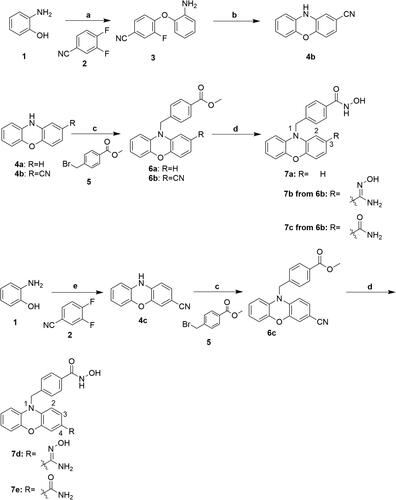
Compounds 12a-d were synthesised as described in Scheme 3. Acid hydrolysis of phenoxazine 4b with C-3 nitrile and of phenoxazine 4c with C-4 nitrile gave acids 8a-b, respectively. Amide coupling of compounds 8a-b with aniline 9a and benzophenone amine 9b provided 10a-d. Compounds 10a-d reacted with compound 5 to produce 11a-d, respectively. Compounds 11a-d were converted to corresponding 12a-d using NH2OH.
Scheme 3. Reagents and conditions: (a) 12 N HCl(aq), AcOH, Δ; (b) EDC, DMAP, DCM, RT; (c) NaH, DMF, RT; (d) i) TH MeOH, 0 °C; ii) 50%NH2OH(aq), NaOH, RT.
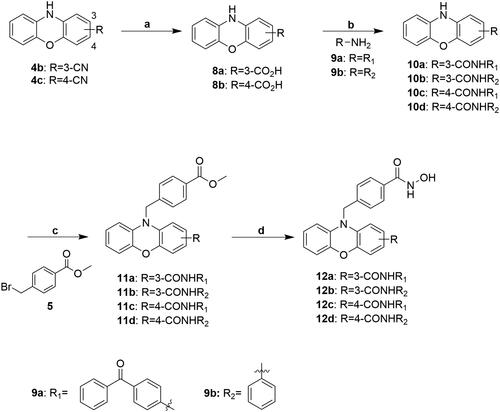
Since the nitrile group is liable to undergo a reaction with the base, the synthetic route of nitrile-containing phenylhydroxamic acid 16 was modified using a mild condition as described in Scheme 4. Benzoic acid 13 was activated to form benzoyl chloride prior to the reaction with NH2OTHP to produce 14. Compound 4c reacted with compound 14 to yield 15. THP deprotection of compound 15 generated phenylhydroxamate 16.
Scheme 4. Reagents and conditions: (a) i) (COCl)2, DMF, CH2Cl2, RT; ii) NH2OTHP, Et3N, CH2Cl2, RT; (b) NaH, DMF, RT. (c)1.25 N HCl-MeOH, RT.
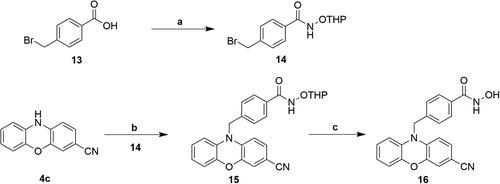
Compounds 18 and 20 were synthesised according to Scheme 5. Bromination of compound 6a using NBS gave 17. Compound 17 reacted with NH2OH to provide 18. Suzuki coupling of 17 in the presence of Pd(PPh3)4 yielded 19. Compound 19 reacted with NH2OH to generate 20.
Scheme 5. Reagents and conditions: (a) NBS, THF, -20 °C; (b) i) THF-MeOH, 0 °C ; ii) 50%NH2OH(aq), NaOH, RT; (c) Pd(PPh3)4, K2CO3, THF, EtOH, H2O, N2, Δ.
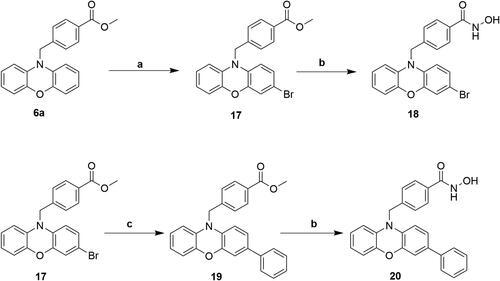
m-Phenoxazine phenylhydroxamic acids 23a-b were synthesised as described in Scheme 6. Compound 4c was reacted with compound 21 to produce 22. Compound 22 reacted with NH2OH to form 23a-b. The Supplementary Material provides details of the synthesis, isolation, and characterisation of intermediates 3, 4b-c, 6a-c, 8a-b, 10a-d, 11a-d, 14–15, 17, 19, and 22, as well as the 1H- and 13C-NMR, and HRMS spectra of compounds 7a-e, 12a-d, 16, 18, 20, and 23a-b. These compounds were determined to be at least 95% pure using HPLC (Supplementary Material).
Results and discussion
HDAC enzyme inhibitory activity
The enzyme-inhibiting activities of compounds 7a-e, 12a-d, 16, 18, 20, and 23a-b against HeLa nuclear HDACs, which include class I HDACs (1, 2, 3), class IIa HDACs (4, 7, 9), and class IIb HDAC6, were evaluated (). SAHA, which inhibits a broad spectrum of HDAC isoform enzymes, is found to protect neuron cells against oxidative stress-mediated neuron damageCitation36. In addition to its in-vitro neuron protection, SAHA not only can alleviate age-related cognition impairment in miceCitation37, but also improves memory function in APP/PS1-induced AD miceCitation38. Therefore, SAHA was tested as a reference compound for comparison with synthesised compounds. The established results show that the five compounds 7b-e and 16 exhibited greater class II HDAC inhibition than SAHA, but with weaker class I HDACs inhibitory activities. Of these, compound 7d exhibited the highest activity. Notably, it not only inhibited HDACs 4, 7 and 9 at sub-μM levels, but also exhibited anti-HDAC6 activity with an IC50 value as low as 3 nM. Compound 7d exhibited more potent inhibition against class II HDACs than unsubstituted compound 7a, suggesting that the C-4 hydroxyimidamide moiety on phenoxazine contributes greatly to the inhibition of these HDAC isoforms. Compounds 7d-e with the C-4 substituent on the phenoxazine ring exhibited stronger class IIa activities than counterpart compounds 7b-c with the C-3 substituent on the phenoxazine ring, suggesting that the C-4 substitution contributes positively to class IIa HDACs enzyme-inhibiting activities. This suggestion was supported by the observation that compounds 12c-d with C-4 arylamide exhibited more potent activities than corresponding compounds 12a-b with C-3 arylamide. Compound 12d had higher enzyme inhibition against tested HDACs, except HDAC7, than did compound 12c, suggesting that the extension of the aryl group weakens the enzyme inhibitory activity. Next, compounds 16, 18, and 20 were synthesised to investigate the relationship between C-4 substituent on phenoxazine and anti-HDAC effect. C-4 Nitrile-bearing compound 16 had less potent enzyme-inhibiting activities against these three classes of HDAC isoform enzymes than did 7d. Similarly, compound 18, which has the C-4 Br on phenoxazine, exhibited moderate enzyme inhibition for class I, IIa and IIb HDACs. Compound 20, which has the C-4 phenyl ring on phenoxazine, exhibited weaker activity towards most HDAC enzymes than did unsubstituted compound 7a, suggesting that the rigid phenyl ring in C-4 position reduces activity. Finally, meta-phenoxazine phenylhydroxamic acids 23a-b were synthesised. A test of enzyme inhibition indicated that these two compounds exhibited much lower HDAC-inhibiting activities than their para-substituted counterpart compounds 7d-e, suggesting that the para-phenoxazine moiety contribute greatly to the enzyme inhibition.
Table 1. IC50a values (μM) of enzyme inhibition of compounds 7a-e, 12a-d, 16, 18, 20, and 23a-b against class I, class IIa and class IIb HDACs.
Binding mode analyses of compounds 7b and 7d for HDAC protein
The molecular docking analysis was performed using the docking software LeadITCitation31 to further understand the interactions between compounds and proteins. The most potent compound 7d was docked into the binding site of HDAC7, which serves as a representative of class IIa HDAC isoforms. As shown in , compound 7d occupies the binding site of HDAC7. Compound 7d contains a hydroxamic acid moiety that functions as the ZBG. Its hydroxamic acid moiety not only chelates with zinc but also forms a hydrogen bond with residues H669 and H670. The aryl linker of compound 7d extends into the tunnel of HDAC7 and generates a π–π T-shaped interaction with residue F679. The phenoxazine of compound 7d served as a cap group to create π–π stacked interactions with surface rim residue F738. Besides that, the C-4 hydroxyimidamide moiety forms three hydrogen bonds with residues N736, F738, and P809. These interactions facilitate compound 7d occupation within the HDAC7 binding site. Additionally, the counterpart compound 7b with the same hydroxyimidamide moiety at C-3 position () is compared with compound 7d to elucidate the key interactions to HDAC7. Both compounds 7b and 7d consist of the same ZBG and linker that form similar interactions to HDAC7. However, the C-3 hydroxyimidamide moiety of compound 7b results in steric clashes and the phenoxazine ring cannot create π-π stacked interactions with surface rim residue F738 (). The loss of the π-π stacked interactions reduces the potency of HDAC7 inhibition activity of compound 7b. Taken together, these findings support that the C-3 and C-4 hydroxyimidamide on phenoxazine cap causes the difference between the HDAC7 inhibitory activities of compounds 7d and 7b.
Figure 1. Interactions analysis of compounds 7b and 7d in HDAC7 binding site. (A) Docking pose of compounds (A) 7d (blue-green) and (B) 7b (yellow) in HDAC7 (light pink). (C) Superimposed docking poses of compounds 7b and 7d in HDAC7. (D) The surface model of the superimposed docking poses for compounds 7b and 7d. The zinc ions are denoted as grey sphere. Chelating bonds are represented by red dash lines, while green dash lines indicate hydrogen bonds. Figures are created using PyMOL.
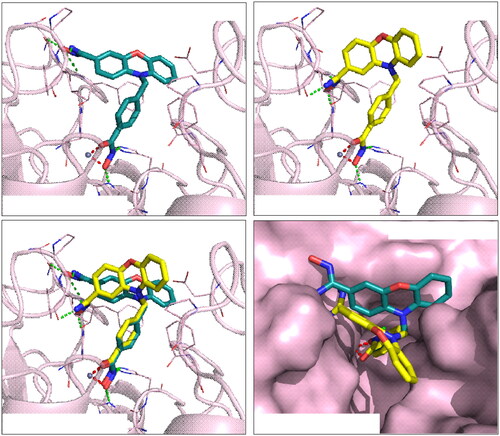
In addition to its potent anti-HDAC7 activity, compound 7d also exhibits excellent inhibitory activity towards HDAC6. Therefore, compound 7d was docked into the binding site of HDAC6 (). The molecular docking result demonstrates that the ZBG group of compound 7d chelates with zinc and generates two hydrogen bonds with residues H610 and G619. The linker of compound 7d spans the hydrophobic tunnel of HDAC6 and its phenyl ring facilitates π–π stacked interactions with residues F620 and F680 and π–π T-shaped interaction with residue H651. The cap of compound 7d has hydrophobic contacts with HDAC6 such as π–π T-shaped interaction with residue F620 and π-alkyl interactions with residue L749. In addition to the hydrophobic interactions, its C-4 hydroxyimidamide moiety on phenoxazine cap also forms two hydrogen bonds with residue L749. The interactions produced by compound 7d correlate its excellent HDAC6 inhibitory activity.
Figure 2. Interactions analysis of compounds 7b and 7d in HDAC6 binding site. (A) Docking pose of compounds 7d (blue-green) in HDAC6 (light blue). (B) Superimposed docking poses of compounds 7b (yellow) and 7d in HDAC6. The zinc ions are denoted as grey sphere. Chelating bonds are represented by red dash lines, while green dash lines indicate hydrogen bonds. Figures are created using PyMOL.
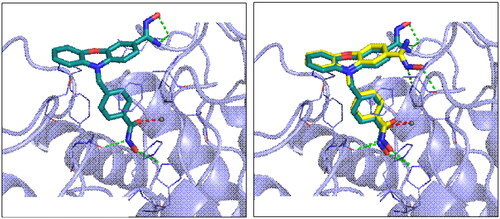
Compound 7b shows HDAC6 inhibitory activity comparable to compound 7d. The docking pose of compound 7b adopts a similar conformation to that of compound 7d (). Compound 7b displays similar polar and hydrophobic interactions compared to compound 7d. Unlike for HDAC7, the C-3 hydroxyimidamide moiety of compound 7b does not cause steric clashes in HDAC6 and creates two hydrogen bonds with residues H651 and F680. Overall, these results demonstrate the C-3 and C-4 hydroxyimidamide of the cap phenoxazine has slight effect on HDAC6 inhibitory activity.
Effects of compound 7d and SAHA on cell viability in human neuroblastoma SH-SY5Y cells
To verify its neuron toxicity, the cytotoxicity of compound 7d at different concentrations towards human neuroblastoma SH-SY5Y cells was evaluated (. SH-SY5Y cells were used to mimic nerve cells. The experimental results show that compound 7d, even at concentrations up to 20 µM, had only a slight cytotoxic effect on SH-SY5Y cells. This compound was less cytotoxic than SAHA. In contrast, SAHA exhibited potent cytotoxicity towards SH-SY5Y cells with an IC50 value of 2.42 μM. These findings suggest that compound 7d exhibited low neurotoxicity.
Figure 3. Effect of compound 7d and SAHA on viability of human neuroblastoma SH-SY5Y cells, as determined by alamar blue assay. All data are provided from three experiments, and each comprised six replicates. *p < 0.05, **p < 0.01, ***p < 0.001 vs control. Statistical analysis was performed using one way ANOVA, followed by a Bonferroni test.
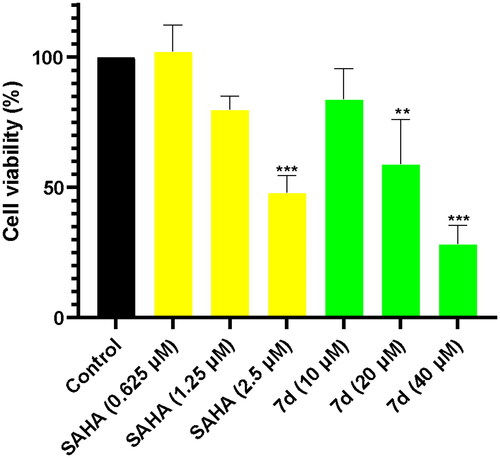
Enhancement of histone and α-tubulin acetylation by compound 7d and SAHA
Acetyl-histone and -tubulin are biomarkers associated with class I HDACs and HDAC6 activity in cells, respectivelyCitation39. Inhibition of these two enzymes increased the levels of acetylation of histone and tubulin protein. The promotion by compound 7d at various concentrations of histone and α-tubulin acetylation in SH-SY5Y cells was evaluated () in the western blotting analysis. Compound 7d induced α-tubulin acetylation in a dose-dependent manner. At the low concentration (0.625 µM) of these tested compounds, the levels of α-tubulin acetylation that were induced by compound 7d exceed those induced by SAHA. Compound 7d, at a concentration as high as 10 µM, only slightly promoted the acetylation of histone H3. These findings are consistent with the data that showed compound 7d not only exhibited higher HDAC6 selectivity than class I HDACs but also exhibited greater HDAC6-inhibiting activity than that of SAHA ().
Neuroprotection of compounds 7b and 7d against H2O2-induced toxicity
The production of excess reactive oxygen species (ROS) is found to be involved in the pathogenesis of various neurodegenerative disorders, including AD, Parkinson’s disease, and amyotrophic lateral sclerosisCitation40,Citation41. Hydrogen peroxide (H2O2), a peroxide molecule of ROS, can cause oxidative stress, which induces cell apoptosis. The HDAC inhibitor Trichostatin A is shown to inhibit the formation of ROS stress granulesCitation42. Compounds 7b and 7d were investigated for the potential to protect human neuroblastoma SH-SY5Y cells from H2O2-induced neuron injury. First, SH-SY5Y cells were treated with various concentrations of H2O2 (Fig. 3S). The concentration of 500 μM of H2O2, which significantly reduced the cell viability to 30.2%, was used to produce neurotoxicity. Compounds 7b, 7d, and SAHA at various concentrations were tested in H2O2-treated SH-SY5Y cells. The results thus obtained demonstrate that compound 7d protected cells against H2O2-induced neurotoxicity in a dose-dependent manner (. Moreover, compound 7b was found to exhibit neuroprotective activity, whereas its activity was weaker than that of compound 7d. The finding is likely due to the superior class IIa HDAC inhibition of compound 7d compared to that of compound 7b. Notably, compound 7d provided greater neuroprotection than SAHA. This compound at sub-μM concentrations (0.313–0.625 μM) significantly restored cell viability. These findings suggest that compound 7d exhibited protective activity against H2O2-induced toxicity.
Figure 5. Protection by compounds 7b, 7d and SAHA against H2O2-induced cytotoxicity in human neuroblastoma SH-SY5Y cells as determined by MTT assay. Compounds are tested at various concentrations and cell injury is induced by H2O2 (500 μM) in human neuroblastoma SH-SY5Y cells. All data are obtained from three experiments. *p < 0.05, **p < 0.01, ***p < 0.001 vs. H2O2.
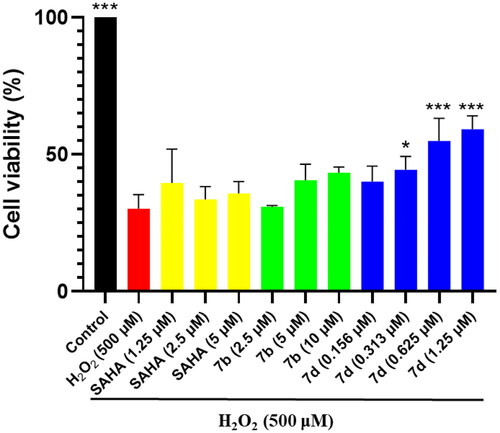
Conclusion
In conclusion, we previously developed a series of phenothiazine-based class II HDAC inhibitors LH4a-g with different C-3 substituents. We intend to investigate extensively the SAR of these compounds for targeting neurological disorders. In this study, the phenothiazine of LH4a-g was replaced with its ring bioisostere phenoxazine which contains various C-3 and C-4 substituents. Some resulting compounds that have the C-4 substituents on phenoxazine exhibited much greater class IIa HDAC-inhibiting activities than those that contain C-3 substituents. Comparisons of the molecular docking of these two series of compounds bound to class II HDACs reveal the differences between the binding modes of C-3 and C-4 substituted compounds. Of the potent C-4 substituted series, compound 7d exhibited the highest enzyme inhibitory activity against class II HDACs (4, 5, 6, 7, 9), but with weaker class I HDAC inhibition compared to SAHA. Compound 7d at sub-μM concentrations remarkably protected neuron cells against H2O2-induced neurotoxicity; however, it was only slightly toxic for cells. Overall, compound 7d, which exhibited potent class II HDAC inhibitory activities, is suggested to be a lead compound for structure optimisation. Further improvement of the biological activities of compound 7d against AD is being undertaken.
Supplemental Material
Download PDF (4.7 MB)Acknowledgements
We gratefully acknowledge the support from the National Science and Technology Council (MOST111-2320-B-038–042-MY3 and MOST110-2320-B-038–024-MY3) in Taiwan.
Disclosure statement
The authors report no conflicts of interest.
Additional information
Funding
References
- Franceschi C, Garagnani P, Morsiani C, Conte M, Santoro A, Grignolio A, Monti D, Capri M, Salvioli S. The continuum of aging and age-related diseases: common mechanisms but different rates. Front Med). 2018;5:61.
- 2020 Alzheimer’s disease facts and figures. Alzheimer’s Dement. 2020;16(3):391–460.
- Burns A, Iliffe S. Alzheimer’s disease. BMJ. 2009;338:b158.
- Tagliapietra M. Aducanumab for the treatment of alzheimer’s disease. Drugs Today. 2022;58(10):465–477.
- Leon R, Garcia AG, Marco-Contelles J. Recent advances in the multitarget-directed ligands approach for the treatment of alzheimer’s disease. Med Res Rev. 2013;33(1):139–189.
- Yamakawa H, Cheng J, Penney J, Gao F, Rueda R, Wang J, Yamakawa S, Kritskiy O, Gjoneska E, Tsai LH. The transcription factor sp3 cooperates with HDAC2 to regulate synaptic function and plasticity in neurons. Cell Rep. 2017;20(6):1319–1334.
- Li JL, Chen JM, Ricupero CL, Hart RP, Schwartz MS, Kusnecov A, Herrup K. Nuclear accumulation of HDAC4 in atm deficiency promotes neurodegeneration in ataxia telangiectasia. Nat Med. 2012;18(5):783–790.
- Tseng JH, Xie L, Song S, Xie YM, Allen L, Ajit D, Hong JS, Chen X, Meeker RB, Cohen TJ. The deacetylase HDAC6 mediates endogenous neuritic tau pathology. Cell Rep. 2017;20(9):2169–2183.
- Govindarajan N, Rao P, Burkhardt S, Sananbenesi F, Schluter OM, Bradke F, Lu JR, Fischer A. Reducing HDAC6 ameliorates cognitive deficits in a mouse model for alzheimer’s disease. EMBO Mol Med. 2013;5(1):52–63.
- Ballatore C, Brunden KR, Trojanowski JQ, Lee VMY, Smith AB, Huryn DM. Modulation of protein-protein interactions as a therapeutic strategy for the treatment of neurodegenerative tauopathies. Curr Top Med Chem. 2011;11(3):317–330.
- Foglietti C, Filocamo G, Cundari E, De Rinaldis E, Lahm A, Cortese R, Steinkuhler C. Dissecting the biological functions of drosophila histone deacetylases by RNA interference and transcriptional profiling. J Biol Chem. 2006;281(26):17968–17976.
- Mazzocchi M, Goulding SR, Morales-Prieto N, Foley T, Collins LM, Sullivan AM, O'Keeffe GW. Peripheral administration of the class-IIa HDAC inhibitor mc1568 partially protects against nigrostriatal neurodegeneration in the striatal 6-ohda rat model of parkinson’s disease. Brain Behav Immun. 2022;102:151–160.
- Tang BL. Class II HDACs and neuronal regeneration. J Cell Biochem. 2014;115(7):1225–1233.
- Anderson KW, Chen JJ, Wang MY, Mast N, Pikuleva IA, Turko IV. Quantification of histone deacetylase isoforms in human frontal cortex, human retina, and mouse brain. PLOS One. 2015;10(5):e0126592.
- Margariti A, Zampetaki A, Xiao QZ, Zhou BD, Karamariti E, Martin D, Yin XK, Mayr M, Li HL, Zhang ZY, et al. Histone deacetylase 7 controls endothelial cell growth through modulation of beta-catenin. Circ Res. 2010;106(7):1202–1211.
- Vallee A, Lecarpentier Y. Alzheimer disease: crosstalk between the canonical wnt/beta-catenin pathway and ppars alpha and gamma. Front Neurosci. 2016;10:459.
- Aizawa S, Teramoto K, Yamamuro Y. Histone deacetylase 9 as a negative regulator for choline acetyltransferase gene in ng108-15 neuronal cells. Neurosci. 2012;205:63–72.
- Yu CW, Chang PT, Hsin LW, Chern JW. Quinazolin-4-one derivatives as selective histone deacetylase-6 inhibitors for the treatment of alzheimer’s disease. J Med Chem. 2013;56(17):6775–6791.
- Ding H, Dolan PJ, Johnson GV. Histone deacetylase 6 interacts with the microtubule-associated protein tau. J Neurochem. 2008;106(5):2119–2130.
- Yang SS, Zhang R, Wang G, Zhang YF. The development prospection of HDAC inhibitors as a potential therapeutic direction in Alzheimer’s disease. Transl Neurodegener. 2017;6:19.
- Sung YM, Lee T, Yoon H, DiBattista AM, Song JM, Sohn Y, Moffat EI, Turner RS, Jung M, Kim J, et al. Mercaptoacetamide-based class II HDAC inhibitor lowers abeta levels and improves learning and memory in a mouse model of Alzheimer’s disease. Exp Neurol. 2013;239:192–201.
- Hsu KC, Chu JC, Tseng HJ, Liu CI, Wang HC, Lin TE, Lee HS, Hsin LW, Wang AHJ, Lin CH, et al. Synthesis and biological evaluation of phenothiazine derivative-containing hydroxamic acids as potent class ii histone deacetylase inhibitors. Eur J Med Chem. 2021;219:113419.
- Thimmaiah KN, Horton JK, Seshadri R, Israel M, Houghton JA, Harwood FC, Houghton PJ. Synthesis and chemical characterization of n-substituted phenoxazines directed toward reversing vinca alkaloid resistance in multidrug-resistant cancer-cells. J Med Chem. 1992;35(18):3358–3364.
- Hernandez-Olmos V, Abdelrahman A, El-Tayeb A, Freudendahl D, Weinhausen S, Muller CE. N-substituted phenoxazine and acridone derivatives: Structure-activity relationships of potent p2x4 receptor antagonists. J Med Chem. 2012;55(22):9576–9588.
- Behl C, Moosmann B. Oxidative nerve cell death in Alzheimer’s disease and stroke: antioxidants as neuroprotective compounds. Biol Chem. 2002;383(3-4):521–536.
- Hajieva P, Mocko JB, Moosmann B, Behl C. Novel imine antioxidants at low nanomolar concentrations protect dopaminergic cells from oxidative neurotoxicity. J Neurochem. 2009;110(1):118–132.
- Yue K, Sun S, Jia G, Qin M, Hou X, Chou CJ, Huang C, Li X. First-in-class hydrazide-based hdac6 selective inhibitor with potent oral anti-inflammatory activity by attenuating nlrp3 inflammasome activation. J Med Chem. 2022;65(18):12140–12162.
- Chao SW, Chen LC, Yu CC, Liu CY, Lin TE, Guh JH, Wang CY, Chen CY, Hsu KC, Huang WJ. Discovery of aliphatic-chain hydroxamates containing indole derivatives with potent class I histone deacetylase inhibitory activities. Eur J Med Chem. 2018;143:792–805.
- Chen LC, Tseng HJ, Liu CY, Huang YY, Yen CC, Weng JR, Lu YL, Hou WC, Lin TE, Pan IH, et al. Design of diarylheptanoid derivatives as dual inhibitors against class IIa histone deacetylase and beta-amyloid aggregation. Front Pharmacol. 2018;9:708.
- Nepali K, Chang TY, Lai MJ, Hsu KC, Yen Y, Lin TE, Lee SB, Liou JP. Purine/purine isoster based scaffolds as new derivatives of benzamide class of HDAC inhibitors. Eur J Med Chem. 2020;196:112291.
- LeadIT v2.3.2, 2019. Sankt Augustin, Germany: BiosolveIT GmBH. Available from http://www.biosolveit.de/LeadIT.
- Burley SK, Berman HM, Bhikadiya C, Bi C, Chen L, Di Costanzo L, Christie C, Dalenberg K, Duarte JM, Dutta S, et al. RCSB protein data bank: Biological macromolecular structures enabling research and education in fundamental biology, biomedicine, biotechnology and energy. Nucleic Acids Res. 2019;47(D1):D464–D474.
- The PyMOL Molecular Graphics System, Version 2.2.1, Schrödinger, LLC.
- Moritomo A, Yamada H, Watanabe T, Itahana H, Koga Y, Akuzawa S, Okada M. Synthesis and structure-activity relationships of new carbonyl guanidine derivatives as novel dual 5-ht2b and 5-ht7 receptor antagonists. Part 2. Bioorg Med Chem. 2014;22(15):4323–4337.
- Eastmond GC, Gilchrist TL, Paprotny J, Steiner A. Cyano-activated fluoro displacement reactions in the synthesis of cyanophenoxazines and related compounds. New J Chem. 2001;25(3):385–390.
- Wu CC, Lee PT, Kao TJ, Chou SY, Su RY, Lee YC, Yeh SH, Liou JP, Hsu TI, Su TP, et al. Upregulation of znf179 acetylation by saha protects cells against oxidative stress. Redox Biol. 2018;19:74–80.
- Peleg S, Sananbenesi F, Zovoilis A, Burkhardt S, Bahari-Javan S, Agis-Balboa RC, Cota P, Wittnam JL, Gogol-Doering A, Opitz L, et al. Altered histone acetylation is associated with age-dependent memory impairment in mice. Science. 2010;328(5979):753–756.
- Benito E, Urbanke H, Ramachandran B, Barth J, Halder R, Awasthi A, Jain G, Capece V, Burkhardt S, Navarro-Sala M, et al. HDAC inhibitor-dependent transcriptome and memory reinstatement in cognitive decline models. J Clin Invest. 2015;125(9):3572–3584.
- Skultetyova L, Ustinova K, Kutil Z, Novakova Z, Pavlicek J, Mikesova J, Trapl D, Baranova P, Havlinova B, Hubalek M, et al. Human histone deacetylase 6 shows strong preference for tubulin dimers over assembled microtubules. Sci Rep. 2017;7(1):11547.
- Wang X, Zhou Y, Gao Q, Ping D, Wang Y, Wu W, Lin X, Fang Y, Zhang J, Shao A. The role of exosomal micrornas and oxidative stress in neurodegenerative diseases. Oxid Med Cell Longev. 2020;2020:3232869.
- Klein JA, Ackerman SL. Oxidative stress, cell cycle, and neurodegeneration. J Clin Invest. 2003;111(6):785–793.
- Feng F, Daw JN, Chen QM. Histone deacetylase inhibitors prevent H2O2 from inducing stress granule formation. Curr Res Toxicol. 2020;1:141–148.


